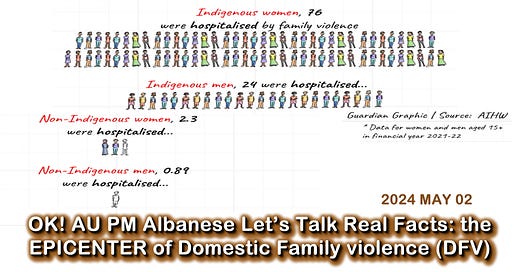DFV IS NOT SOME EMERGING ISSUE
2015 JUL 28
Feature Video: Indigenous victims of domestic violence
Aboriginal women represent three per cent of all women in Australia, yet they make up six times that amount in family violence victims. One woman in Melbourne is determined to shed light on their stories and ensure they are not forgotten, and a group of women in Alice Springs is at the forefront of a movement tackling family violence in their community.
“without prejudice” Opinions
Indigenous (First Nations) Biological Women 33 times more likely to be hospitalised
~ (The Guardian)
Domestic Family violence: (DFV)
For the Gender Confused
Woman/Female:
A person with XX chromosomes usually has female sex and reproductive organs [ovaries, womb, cervix and vigina], and is therefore usually assigned biologically female.
Man/Male:
A person with XY chromosomes usually has male sex and reproductive organs testicles and penis, and is therefore usually assigned biologically male.
CULTURAL “Man/Men/Male” DEMOGRAPHIC!
Indigenous Aboriginal and Torres Strait Islander Biological “Women/Females”
33 times more likely to be hospitalised than non-Indigenous women.
The Guardian: Aboriginal and Torres Strait Islander people are disproportionately affected1 by family and domestic violence.
In 2021-22, Indigenous women aged 15 and over were 33 times more likely to be hospitalised due to family violence than non-Indigenous women. Indigenous men were 27 times more likely than non-Indigenous men.
The number of Indigenous people hospitalised due to family violence in 2021-22 was 3,100 (2,400 women and 740 men). Similar numbers of non-Indigenous Australians were hospitalised by family violence, but Indigenous Australians2 represent just 3.8% of the population.
GEOGRAPHICAL: Remote and Very Remote Areas
Hospitalisation rates due to family violence are higher in remote and very remote areas, and Indigenous families also risk having their children removed by the state3 if they ask for help.
INDIGENOUS vs. NON-INDIGENOUS HOMICIDE
According to new data released this week4, Indigenous people are disproportionately the victims of homicide. The homicide victimisation rates for both Indigenous men and women are about seven times higher than non-Indigenous Australians of the same sex.
Family, Extended Family, Community Violence
“Family violence” covers violence among extended family and community, and is the preferred term5 within Indigenous communities. The hospitalisations data comes from the AIHW National Hospital Morbidity Database.
RELATED
2016 JUL 08 The Unspoken Epidemic of Violence in Indigenous Communities
Jacinta Nampijinpa Price is a Walpiri/Celtic woman who grew up in Alice Springs. In 2015, Jacinta was elected into Alice Springs’ Town Council and is deeply involved within her community as well as remote communities of the Northern Territory. Jacinta advocates against violence against women and the need for positive cultural change. Through the platforms of music, women’s AFL, and local government Jacinta has worked to empower young Indigenous girls and women while campaigning for the need for Indigenous people to take back responsibility to resolve entrenched issues. WATCH HERE
Acknowledgements Original Sources
{EDITORIAL: Indigenous (First Nations) Biological Women 33 times more likely to be hospitalised than non-Indigenous women. | Published: 02/MAY/2024 | Publisher: The Guardian | by Josh Nicholas | SEE URL: https://www.theguardian.com/news/... }
{VIDEO: Indigenous victims of domestic violence | Publisher: SBS The Feed | Published: 2015 JUL | 28 WATCH HERE
{EDITORIAL: Aboriginal women continue to be subject to horrific violence – we cannot leave them out of the conversation Published: 01/MAY/2024 | Publisher: The Guardian | by Vanessa Turnbull-Roberts | SEE URL: https://www.theguardian.com/commentisfree/2024/may/01/aboriginal-women-continue-to-be-subject-to-horrific-violence-we-cannot-leave-them-out-of-the-conversation }
{News Group: Indigenous Australians News | Publisher: The Guardian | SEE URL: https://www.theguardian.com/australia-news/indigenous-australians }
{HREOC: Report of the National Inquiry into the Separation of Aboriginal and Torres Strait Islander Children from Their Families | Published: April 1997 | Publisher: Human Rights and Equal Opportunity Commission (HREOC) Report | SEE URL: https://humanrights.gov.au/our-work/projects/bringing-them-home-chapter-20 }
{EDITORIAL: New homicide statistics show surge in intimate partner killings – and huge disparity in First Nations victims | Published: 29/APR/2024 10.04pm AEST| Publisher: The Conversation | by Steven Saphore/AAP | SEE URL: https://theconversation.com/new-homicide-statistics-show-surge-in-intimate-partner-killings-and-huge-disparity-in-first-nations-victims-228890?utm_source=pocket_saves }
{AU Gov: FDSV: Aboriginal and Torres Strait Islander people | Published: Topic last updated: 12/APR/2024 | Publisher: Family, domestic and sexual violence (FDSV) | SEE URL: https://www.aihw.gov.au/family-domestic-and-sexual-violence/population-groups/aboriginal-and-torres-strait-islander-people }

















Share this post